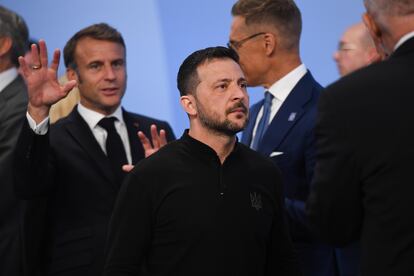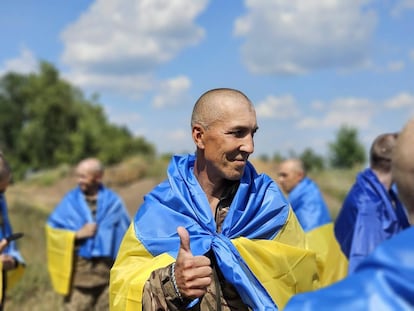Volodymyr Zelenskiy’s peace plan: Three meetings and a summit with (preferable) Russian participation
The president of Ukraine wants to organize conferences on energy and food security, and the return of prisoners of war and deported minors, between July and September. Moscow is refusing to participate in a second round of dialogue


The word negotiation is still regarded with some suspicion among Ukrainian citizens. It had been put in a drawer and the key thrown away during months of resistance and counterattack against the Russian invasion. Nor was it on the government’s lips on a daily basis. But two and a half years after the start of the war it is beginning to sound, even if it does so as the final stage of a process in which President Volodymyr Zelenskiy has fully immersed himself. The Ukrainian leader, together with his cabinet, led by Andrii Yermak, and the diplomatic work of his foreign minister, Dmytro Kuleba, wants to accelerate the next stages marked on his road map prior to the holding of a second peace summit, with possible Russian representation, foreseeably before the end of the year.
If this plan succeeds, negotiations will inevitably follow. It is a difficult puzzle to complete at a complicated moment for the Ukrainian army, which is under great pressure in the Donetsk sector, and a citizenry which is perhaps not on the same page as the government: according to a survey carried out by the Razumkov Center, only 44% of Ukrainians believe that the time has come to negotiate. 61% would not give in on anything that, a priori, Russia demands, such as the ceding of territory, with 84% unwilling to hand over the occupied provinces to Moscow. Furthermore, 51% said a minimum condition for dialogue is the restoration of Ukraine’s borders to their 1991 limits, a red rag to the Kremlin. Sixty-six percent said they believed a military victory is still possible.
After several international meetings at ministerial or advisory level on security issues in Copenhagen, Jeddah, Malta and at Davos, Zelenskiy’s objective for this year, at least publicly, was to achieve the peace summit held on June 15-16 in Bürgenstock (Switzerland). And he succeeded. The communiqué, currently with 87 signatures of support, envisaged progress on three of the 10 points of the Ukrainian president’s peace plan (the so-called Zelenskiy Formula): energy security — including regaining control of the Zaporizhzhia nuclear power plant — food security and, finally, the exchange of prisoners and the return of Ukrainian children held by the Russian authorities.
In Switzerland, Zelenskiy went one step further and expressed his desire to organize a second meeting later this year to make progress towards a “just peace.” Out of the corner of its eye, Kyiv is watching the rise in the polls of Republican candidate Donald Trump and his running mate on the ticket, J. D. Vance, who is opposed to maintaining aid to Ukraine. At a press conference last Monday, Zelenskiy laid out the steps prior to a new conference, a road map that includes a meeting in July or early August in Qatar to discuss energy; another in August, to be held in Turkey, regarding free access to trade in grain through the waters of the Black Sea, and a third meeting in Canada in September on the return of prisoners of war and minors deported to Russia.
If there is success on those three points, the president has asked his team to have a plan ready by November (presidential election month in the United States) with the rest of his peace formula, with a view to holding a second summit, with an extra stipulation: “I think that representatives of Russia should attend,” Zelenskiy said on Monday. It would be at this hypothetical meeting that the withdrawal of Russian troops and the cessation of hostilities would be discussed.
This diplomatic framework is exposed, however, to what happens on the front lines. “Unfortunately,” Serhii Kuzan, president of the Ukrainian Center for Cooperation and Security (USCC), notes in an exchange of messages that “the country is currently not in the best position to start negotiations. Today, Russia holds the initiative on the battlefield.” Kuzan, a former advisor to the Ukrainian Defense Ministry, believes, however, that there will be changes in the fall as the potential of the Russian summer campaign begins to fade. “Russia is now at the peak of its capabilities,” the analyst continues. “While Western partners, on the contrary, are opening factories in Ukraine, providing additional assistance, and [Kyiv’s] own defense industrial complex is gaining capacity.”
There are light and dark sides to the first part of the plan outlined by Zelenskiy. Although Ukrainian society has shown its resilience during the Russian offensive on the country’s energy infrastructure, the damage to the sector has been enormous. Since March, Moscow has been shelling the electricity system, both thermal plants — essential after the reduction of nuclear power flow in the occupied territories — or simple substations. According to recent estimates by Ukrainian officials for the Financial Times, Ukraine generates half the power it did before the invasion. The damage to the country’s economy and the power cuts suffered by citizens are taking their toll.
Also in the realm of the chiaroscuro is the return of the military personnel captured by the enemy and of the children forcibly deported to Russia. Since May alone, Ukraine has recovered 259 soldiers in three batches. Russia has obtained the same number of prisoners of war in exchange. Military exchanges are progressing at a good pace, while only 388 of the 20,000 children identified by the government as having been transferred to occupied territory or directly to Russia have been returned.
Thanks to the pressure maintained in the Black Sea, through bombardments and sea drones launched against the Russian fleet, Kyiv’s cargo ships have been able to return to the Bosphorus and are regaining pre-2022 Ukrainian grain export levels.

Even if these points of Zelenskiy’s plan come to fruition, it would, barring a huge surprise, be met with the Kremlin’s flat refusal to attend the peace summit. Russia’s participation is not only desirable for Kyiv; at the Switzerland meeting, powers such as China and Brazil, currently very relevant for the Ukrainian government, did not attend, alleging the absence of envoys from Moscow. A few hours before the Bürgenstock summit got underway, Russian President Vladimir Putin laid out as conditions for initiating talks the recognition of the provinces of Donetsk, Luhansk, Zaporizhzhia and Kherson (none of which are completely controlled by the Russian army) as Russian territory, as well as the demilitarization of Ukraine and the blocking of its bid to join NATO. These three red lines would amount, according to the Institute for the Study of War, to a request for “capitulation.” On July 12, Russian Deputy Foreign Minister Mikhail Galuzin insisted that Moscow would not be present at a second round of peace talks and called the Zelenskiy Formula an “ultimatum” and a “dead end.”
“There is a lack of understanding and constructive attitude on the part of the Russians,” notes Serhii Kuzan of the USCC. “They are not guided by the basic principles of negotiations but rather pose ultimatums that cannot be met on capitulation or surrender of territories. Ukraine talks about a step-by-step solution to this military problem, and the Russians speak the language of manipulation in various forms to legalize the illegal occupation of Ukrainian territories, to have sanctions removed, and to stop arms supplies to Ukraine. They want to gain time to wait for a change in the political situation in Europe and in the world, to attack even more with new forces. They hope that the world will get tired of what they call the ‘Ukrainian crisis.’”
Sign up for our weekly newsletter to get more English-language news coverage from EL PAÍS USA Edition
Tu suscripción se está usando en otro dispositivo
¿Quieres añadir otro usuario a tu suscripción?
Si continúas leyendo en este dispositivo, no se podrá leer en el otro.
FlechaTu suscripción se está usando en otro dispositivo y solo puedes acceder a EL PAÍS desde un dispositivo a la vez.
Si quieres compartir tu cuenta, cambia tu suscripción a la modalidad Premium, así podrás añadir otro usuario. Cada uno accederá con su propia cuenta de email, lo que os permitirá personalizar vuestra experiencia en EL PAÍS.
¿Tienes una suscripción de empresa? Accede aquí para contratar más cuentas.
En el caso de no saber quién está usando tu cuenta, te recomendamos cambiar tu contraseña aquí.
Si decides continuar compartiendo tu cuenta, este mensaje se mostrará en tu dispositivo y en el de la otra persona que está usando tu cuenta de forma indefinida, afectando a tu experiencia de lectura. Puedes consultar aquí los términos y condiciones de la suscripción digital.
More information
Archived In
Últimas noticias
Most viewed
- Reinhard Genzel, Nobel laureate in physics: ‘One-minute videos will never give you the truth’
- Oona Chaplin: ‘I told James Cameron that I was living in a treehouse and starting a permaculture project with a friend’
- Pablo Escobar’s hippos: A serious environmental problem, 40 years on
- Charles Dubouloz, mountaineering star, retires at 36 with a farewell tour inspired by Walter Bonatti
- Why we lost the habit of sleeping in two segments and how that changed our sense of time










































